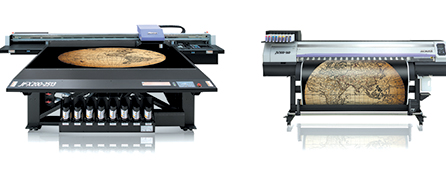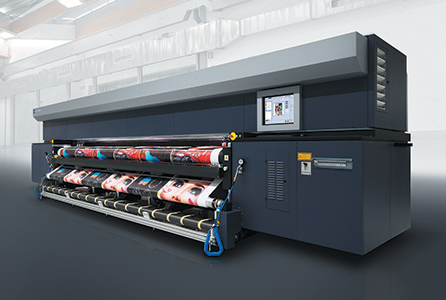 Myth or reality?
Myth or reality?
When discussing hybrid printers recently, an analogy was drawn with an
item of domestic white goods—the washer/dryer. Now, I could relate to
this. From experience, I can vouch for the fact that while it seems a
great idea to have the two functions in one machine, when it comes to
the practicalities (combined with the vagaries of our British weather)
it is far from ideal. Only one operation can be performed at any one
time, which means you end up with a backlog of either wet washing
waiting to be dried or dirty items waiting to be washed.
So, it is with a hybrid printer—you can only programme it to operate in either flatbed or roll-to-roll mode at any one time.
However, new models and technical advances continue to be developed, so
there is clearly a market for these machines and I was curious to find
out more about the pros and cons from some of the leading manufacturers
and suppliers of this technology.
Agfa will reveal, for the first time in the UK and Ireland, its new
Anapurna H1650i LED at Sign and Digital UK. Agfa’s distribution
partners, I-Sub Digital (stand J36) and Josero (stand C22) will
demonstrate and explain the features and benefits of this exciting new
1.65m hybrid wide-format press. The Anapurna H1650i LED was designed as
an accessible and cost-effective production tool that combines the
latest LED technology with Agfa’s signature high-quality output. Agfa
will also have on display a creative application wall on Antalis’ stand
(L10) showcasing creative ideas from Agfa’s range of Anapurna and Jeti
wide-format inkjet systems.
This is the latest addition to the Anapurna LED series, and is a smaller
version of the popular and robust Anapurna H2050i LED press, with which
it shares several features and benefits. Like its bigger brother, the
new Anapurna H1650i LED prints on both rigid and flexible media and
cures with air-cooled UV LED lamps, resulting in a lower total cost of
ownership. It combines this with Agfa’s award-winning imaging quality,
ink-saving Thin Ink Layer Technology, and reliable white ink printing,
yet requires a smaller financial investment than other systems in this
segment.
“The hybrid Anapurna H1650i LED system was designed as a robust,
qualitative, and versatile entry-level option for wide-format
print-service-providers,” explains Steve Collins, marketing and channel
manager at Agfa Graphics UK and Ireland. He adds: “Although smaller, it
is equipped with features normally reserved for higher-end systems,
ticking all the boxes for printing a wide range of rigid and flexible
materials.”
The technology provides industry-leading levels of accuracy thanks to a
reinforced belt drive and shuttle beam, a gradient and multi-layer print
functionality, and up to eight 12 picolitre KM1024i print heads.
To be…?
Now, putting the case firmly for hybrids, Phil Oakley, UKI large-format
business manager at HP, comments: “Recent developments in the
wide-format hybrid industry have streamlined user experience and allowed
customers to keep up with growing demands from clients. With one
device, sign-makers and print-service-providers (PSPs) can now offer
faster turnarounds on projects, whilst never slipping on quality.”

Phil Oakley, UKI large-format business manager at HP, says that the new HP Latex R Series, with its new hybrid HP Latex printing technology, will enable sign-makers and PSPs to expand their offering into new, high-value applications
HP has a long-standing heritage in the wide-format hybrid market and in
March 2018 the company launched the new HP Latex R Series, which it
claims to be the first true hybrid HP Latex printing technology—offering
both flexible and rigid printing with HP Latex inks.
“This industry breakthrough will be the first solution to produce
totally odourless, flexible, and rigid prints with eco-friendly,
original HP Latex water-based inks,” asserts Oakley, adding: “The new
series is a huge development for HP, and one that we hope will disrupt
the current market.
“This trailblazing technology will enable sign-makers and PSPs to expand
their offering into new, high-value applications, whilst also creating
the opportunity for fresh creative ideas and concepts for sign and
display customers.”
Pointing out the benefits of hybrid, Oakley continues: “Wide-format
hybrid devices provide a unique advantage for sign-makers and PSPs with
less space, allowing smaller businesses to compete with larger firms for
projects and avoid the need to sub-contract services out to their
competitors, thus reducing profitability. Hybrid devices are ideal for
smaller sign-makers and PSPs that want the flexibility and the agility
to move between rigid and roll-to-roll printing and can help them grow
their businesses with new applications.

Hybrid devices are ideal for smaller sign-makers and PSPs that want the flexibility and the agility to move between rigid and roll-to-roll printing and can help them grow their businesses with new applications”
“For many years, we’ve seen a great response from customers to our
wide-format hybrid offering, and, as a result, we have watched this area
of our business steadily grow. What we’re aiming to do with our new HP
Latex R Series is shake up the market and forge new opportunities for
sign-makers and PSPs.”
…or not to be?
John de la Roche, national sales manager at Hybrid Services, highlights the benefits of separate machines.
“There are times when a hybrid printer is the more suitable option,”
says de la Roche, adding: “Space in your premises may dictate, or budget
in fact. However, there remains a very strong argument for investing in
separate roll-to-roll and flatbed hardware.”
However, he stresses that the most obvious benefit in operating with
separate machines is that of productivity: “If you have a hybrid machine
you can only process one print job at a time, using only one printing
technique. If you have separate machines you can carry out different
jobs simultaneously.
O Factoid: The word ‘hybrid’ was first recorded in 1595 to 1605 from the Latin word hybrida, hibrida a crossbred animal (Dictionary.com). O
“Combining popular Mimaki products such as the JFX200 8 x 4’ LED UV
flatbed printer with a roll-to-roll option such as the high-speed JV300
solvent printer or the versatile new UCJV LED UV roll-fed printer/cutter
is a productive and profitable solution.”

John de la Roche of Hybrid Services says combining Mimaki products such as the JFX200 printer with a roll-to-roll option such as the JV300 solvent printer is a “productive and profitable solution”
The JFX200 delivers a highly desirable combination of quality, speed,
and value. Its flatbed format means that it is ideally suited to the
production of rigid display boards, packaging, and exhibition panels,
while Mimaki roll-to-roll printers are ideal for producing complementary
flexible graphics such as banners, posters, and vehicle liveries in
high volumes and using a choice of ink types.
“With two different types of wide-format print technology in their
arsenal, professional sign and graphics producers now have the
opportunity to expand their business horizons by meeting customer
demands ever more effectively, with better productivity and
profitability as the ultimate prize,” asserts de la Roche.
He adds: “Add to the mix the creative opportunities available with the
JFX200, such as glass splashbacks or printed tiles, along with the many
textile printing options of the UCJV, including in-demand backlit
printing for lightboxes, and it’s easy to see how keeping things
separate will benefit their print business.”
On balance
Bringing an element of balance into the equation, Peter Bray, managing
director of Durst UK and Ireland, observes: “One obvious big advantage
of hybrid systems is the ability to print efficiently on roll-to-roll
and flatbed. But then there’s also the versatility and smaller footprint
benefits. There are no mask requirements for the printing bed, meaning
continuous production is achieved and you don’t have to place individual
sheets onto a flatbed.”

Peter Bray, managing director of Durst UK and Ireland, says that the company works extremely closely with customers to ensure they have the best machine suited to their individual needs
Conversely, Bray notes that there can be a perception among some
customers that hybrid machines tend to have lower productivity compared
to individual roll-to-roll and flatbed systems.
“Another potential concern can be registration, with some applications
such as double-sided printing sometimes proving difficult on a hybrid,”
continues Bray, adding: “However, with our hybrid machines, we have a
very large bed size up to 2.5 x 1.5m with multiple channel vacuum zones
allowing our customers to gain pin-point registration.
“In our experience, customers who have volume production for
roll-to-roll applications will have individual roll-to-roll machines
such as the Durst Rho 312 and Durst Rho 512, both of which allow
unattended printing. They can then complement this with a hybrid
machine, such as the highly regarded Durst P10 range and now the new
Durst P5, which was formally launched in February.”

Durst has found that customers who have volume production for roll-to-roll applications will have individual roll-to-roll machines, such as the Rho 512R Plus, which allow for unattended printing
Bray emphasises: “Sign-makers are an important target audience for
Durst. Our customers tell us they are looking for versatility,
outstanding productivity, and good adhesive qualities by whether it’s
roll-to-roll or flatbed; and they increasingly see the benefits of a
hybrid system.
“We’re proud to have a portfolio of products that are robustly designed
to accommodate the requirements of every print-service-provider. We work
extremely closely with our customers in the sales and evaluation
process to ensure they have the best machine suited to their individual
needs, whether that’s roll-to-roll, flatbed or a hybrid.”
In summary, there are benefits to be gained from both hybrid and
separate roll-to-roll and flatbed machine options or, indeed, a
combination of both. The ‘tipping’ factors in the decision as to which
route to take are the matters of floor space and production volume.
Your text here...
Your text here...